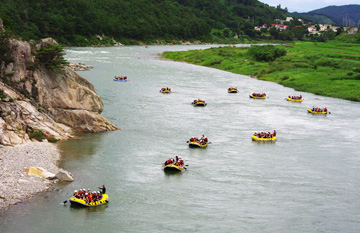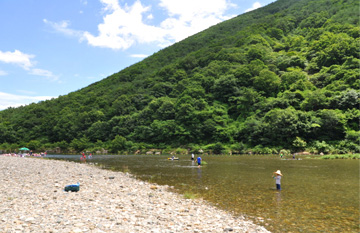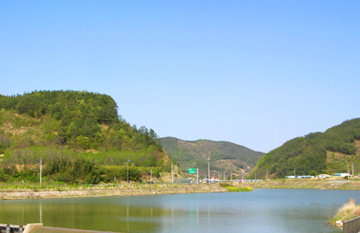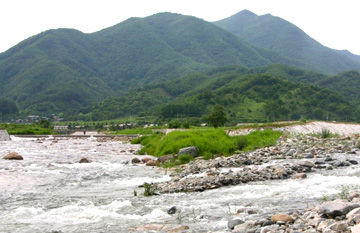Rivers

The Gyeonghogang River is the channel of water running approximately 32km from Gangjeong, Eoseo-ri, Saengcho-myeon to Jinju Jinyangho Lake. Since it runs along the National Road 3 and along the highway between Jinju and Hamyang, even the passengers in the cars and enjoy the beauty of the Gyeonghogang River.
In addition, the river is wide with no large boulders, but with sediments of sand grains and small pebbles, making the rapids to flow fast but without sudden vortex. The river is ideal for rafting and as a matter of fact, it is the only rafting river south of the Hangang River.
Rafting along the course of clear river waters as the boat bounces on the rolling rapids is the sports for the young challenging spirit and many people come to Gyeonghogang River in Sancheong to test the rapids of the river all year round.

Deokcheongang River rises in Sancheong and its water cleanses Sancheong's spirit. This river is the setting of sanctuaries that honor the guardian spirits of the Shilla and Goryeo dynasties, in a region where many conscientious subjects of the Goryeo Dynasty opposed the upheaval that led to the founding of the Joseon Dynasty. The river has the mystique that comes from its association with Jirisan’s rich history.
The river tells us endless stories of sorrow that have become instilled in this great mountain: the river encompasses Cheonwangsaem Spring, which bubbles up from under Cheonwangbong Peak in Jirisan Mountain, Jeseokcheon, which shelters the sanctity of Jirisan Mountain, Mujechigi Falls, which gave birth to the legend about Hoya and Yeonjin and is said to engender its own rainbows with the water of the Jungsalli Valley that flows down from Eumyangsusaem Spring, Daewonsa Temple, serene with the chanting voices of the pure-hearted Buddhist nuns, and Deokcheon Yangdansu, where the water from Daewonsa Temple converges, and even Jinyangho Lake.
Yangdansu is at the point where the water that flowed down from Jungsalli Valley converges with the water from the Daewonsa Valley.
Our ancestors often described this place as paradise: how clear the water and how beautiful the scenery must have been to merit that the title of paradise? Nammyeong, a revered Confucian teacher, eschewed positions in the royal government all his life and instead resided near Yangdansu, with views of Jirisan Mountain, where he established Sancheonjae and taught through his own example the principles of Gyeonguihak, a school of thought that emphasizes the values of “disciplining the heart inside and practicing righteousness outside.”
Many of the scholarly elite who were influenced by Nammyeong’s teachings later took the lead in recruiting soldiers (called “uibyeong”) and fighting to defend the nation during the years of the Japanese Invasion in the Japanese Invasion of Korea in 1592. There were nearly fifty disciples of Nammyeong who served as Generals who led uibyeong soldiers, including Hongui Janggun Gwak Jae-u (郭再祐), Jeong In-hong, and Choe Yeong-gyeong. This impressive record underscores the power of the ideas that flourished here, representative of the western region of Yeongnam, nourished by the water of Deokcheongang River flowing down from Jirisan Mountain, comparable in influence to the school of thought that flourished under the leadership of Toegye Yi Hwang, whose influence was centered in Andong, Gyeongsangbuk-do, in the regions watered by the Nakdonggang River.
Deokcheongang River is the river that contains all the essences of Jirisan Mountain. With Cheonwangbong Peak at the center, the southern ridge---which stretches through Jeseokbong Peak, Yeonhabong Peak, Chotdaebong Peak, Yeongsinbong Peak, and Samsinbong Peak---forms Beopcheon Valley, Cheongnaegol Valley, Dojanggol Valley, Georimgol Valley, and Godundong Valley. There are also valleys formed by the Gugoksan Mountain’s ridge, which split off from Jungbong Peak and the Chibatmok Pass, namely Sunduryu Valley, Cheonjiamgol Valley, Naewongol Valley, and Jangdangol Valley. Then there are the valleys created by the Wangdeungjae Ridge—which stretches from Cheonwangbong Peak to Jungbong Peak and onwards to Habong Peak, Ssukbatjae Pass, Saejae Pass, Gitdaebong Peak, Bammeorijae Pass--and the Ungseokbong Mountain Ridge: these are the Jogaegol Valley, Daewonsa Valley, and Ttakbatsilgol Valley. All of these valleys are tributaries of the Deokcheongang River.
In the past, the people of these valleys resorted to slash-and-burn farming and used charcoal kilns. This means that the people gathered here found it hard to make a livelihood, and Deokcheongang River is the repository of many of their sorrowful stories. Even when there are no red autumn leaves, the ripples of the water on Deokcheongang River looks crimson in the sunset—perhaps the color symbolizes the pain of the common people who lived through the vicissitudes of Jirisan’s history.
Deokcheongang River continues to flow through its sinuous course headed for the lower lands, in a manner that seems like a mimicry of the lives of the people who find themselves in Jirisan Mountain. Sometimes its course is blocked by the foot of a mountain, and the river rushes forth as though impatient to move ahead; sometimes it moves in enraged currents as though it feels the urge to sweep across the fields relentlessly; ultimately, however, it descends humbly into the lower places.
This is why Deokcheongang River is a river that reminds us of both sorrow and true humanity.

Yangcheongang River is a river that flows through Saengbiryang-myeon, Sancheong-gun and Sinan-myeon. It originates in Hapcheon-gun Jagulsan Mountain, passes through Ssangbaek-myeon, Hapcheon-gun and Daeui-myeon, Uiryeong-gun to flow into Sancheong and merge with the water of Dangyecheon. Finally, it converges with Gyeonghogang River and flows into Namgang River. It is also known by the name 'Saengbiryangcheon Stream.’
Over its long, 60km course from its origin, this river has nurtured the region, providing water for daily and agricultural use. The flow is gentle, however, and after the construction of the Namgang Dam, there has frequently been damage from flooding during the rainy season. There was once a time when the sweet-fish and dace caught in this river were considered delicacies, but these species have vanished after the construction of the dam.
The scenery observed along the riverside road stretching from Uiryeong to Daeui is first rate, and in the direction of Dojeon-ri in Saengbiryang-myeon, you can visit the Rock-carved Buddhas and Eoeunseowon Confucian Academy which earned royal recognition under the leadership of scholar Uam Song Si-yeol.

“Yangdansu” refers to two separate streams of water descending from different valleys, and therefore places named “Yangdansu” are located where two waterways meet and merge.
Yangdansu may consist of two rivers that are equivalent in size and length, but there are also cases where one of the two rivers is shorter or narrower.
However, Yangdansu always converge into one flow, and the combined rivers merge and blend together rather than one exerting itself to be a stronger current than the other. Thus both are rendered both far more gentle and harmonious in character. If we take a moment to reflect on the symbolism of this convergence, a visit to Yangdansu may feel all the more meaningful.
As the two currents of water combine at Yangdansu, a unique topography is formed. In most cases, white beaches of sand or pebbles are formed over a broad stretch of land, and this is why Yangdansu are often favorite spots for recreation and rest.
The properties of the two currents of water that converge at Yangdansu may be different from one another: the water from a shorter valley stream tend to be colder and clearer, while water from a broad and long river will not have as low a temperature. For this reason, the point of convergence of the Yangdansu can be very dangerous for swimmers in the summertime. Even within a small area, the temperature of the water may change rapidly, which can often trigger heart failures and accidents: visitors should take extra caution.